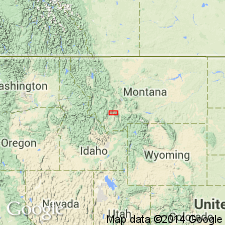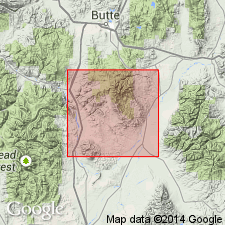
- Usage in publication:
-
- Table Mountain Quartzite*
- Modifications:
-
- Named
- Dominant lithology:
-
- Quartzite
- AAPG geologic province:
-
- Northern Rocky Mountain region
Summary:
Named as formation in lower Belt of Belt Supergroup. Type locality designated as along south side of East Peak, 1.6 km east of Table Mountain in Highland Mountains, Silver Bow Co, MT, Northern Rocky Mountain region. Type section (measured, fig. 8) is in secs 14, 23, T1S, R7W. Named for conspicuous white quartzite exposed on Table Mountain; however, type locality is on East Peak because entire formation is best exposed in south-facing glacial cirque carved into southern face of peak. Thickness is about 530 m at type; thins to 240 m on unnamed peak 2 km west of type; pinches out farther to west; is not present west of Twin Bridges fault. Thins to east where it is cut out by Rader Creek and Donald plutons of Boulder batholith. Divided into a lower member consisting of 262 m of massive, thick-bedded, cliff-forming white quartzite; and an upper member consisting of 266 m of thin-bedded, upward-fining quartzite interlayered with minor siltite and argillite. At type section, overlies conglomerate of LaHood Formation of lower Belt; upper contact is placed at top of highest white quartzite bed below Greyson Shale of Ravalli Group of Belt. To west of type, Table Mountain interfingers with Newland Formation of lower Belt; to east on East Table Mountain, tongue of Newland is in middle of unit. Schematic cross section (fig. 2); correlation diagram (fig. 3). Middle Proterozoic age.
Source: GNU records (USGS DDS-6; Denver GNULEX).

- Usage in publication:
-
- Table Mountain Quartzite*
- Modifications:
-
- Mapped 1:50k
- Dominant lithology:
-
- Quartzite
- Siltite
- Argillite
- AAPG geologic province:
-
- Northern Rocky Mountain region
Summary:
Mapped in central part of Highland Mountains, southwestern MT, Northern Rocky Mountain region. Is within lower part of Belt Supergroup. Lower and upper parts separately mapped. Lower part consists of about 250 m of quartzite overlain by interbedded clean to argillaceous quartzite, siltite, and argillite. Upper part consists of massive white quartzite beds separated by 1- to 5-m-thick, upward-fining sequences of intraformational conglomerate quartzite, siltite, and argillite. Thins and pinches out to west and is locally interlayered with Newland Formation on east. Maximum thickness is over 500 m. Overlies with gradational contact, LaHood Formation of Belt. Also correlates in part with Moose and Greyson Formations of Belt. Middle Proterozoic age.
Source: GNU records (USGS DDS-6; Denver GNULEX).
For more information, please contact Nancy Stamm, Geologic Names Committee Secretary.
Asterisk (*) indicates published by U.S. Geological Survey authors.
"No current usage" (†) implies that a name has been abandoned or has fallen into disuse. Former usage and, if known, replacement name given in parentheses ( ).
Slash (/) indicates name conflicts with nomenclatural guidelines (CSN, 1933; ACSN, 1961, 1970; NACSN, 1983, 2005, 2021). May be explained within brackets ([ ]).

